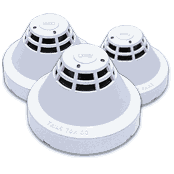 Specifying
a life safety system without Signature Series multisensor
technology is like driving a car without rear-view
mirrors: you'll get where you want to be, as long
as nothing unexpected comes up from behind. But life
safety is all about the unexpected, so it pays to
make sure you're covered.
Specifying
a life safety system without Signature Series multisensor
technology is like driving a car without rear-view
mirrors: you'll get where you want to be, as long
as nothing unexpected comes up from behind. But life
safety is all about the unexpected, so it pays to
make sure you're covered. Signature Series detectors offer true multisensor technology and exquisite reliability that virtually does away with false alarms. They accomplish this by means of an on-board microprocessor that constantly monitors the state of its sensors. Using a sophisticated algorithm, the microprocessor effectively distinguishes between a legitimate change of state and a non-threatening situation that would otherwise lead to a false alarm.
FEATURES:
What's more, true multisensor technology means that a single device can perform optimally under a wider range of conditions than any single-sensor detector. And that's where the rear-view mirrors come in.
Photoelectric and ion detectors see smoke, but not all fires produce it. Heat detectors, on the other hand, spot temperature changes, but these aren't always an indicator of a life-threatening event. Multisensor devices, however, collect data on several different environmental parameters at the same time, and then weigh the results to determine whether an alarm should be sent to control panel.

Multisensor or not, all Signature detectors feature analog technology. This allows them to gather information continuously concerning the state of their sensors and track the results over time. As detectors become dirty, the on-board microprocessor makes minute adjustments to the alarm threshold, thus avoiding false alarms. And when the threshold approaches the point where the device sensitivity could become compromised, the detector automatically sends a message to the control panel indicating that it's time for a cleaning.
This means that detectors are always at their peak level of performance. In fact, Signature Series detectors have been singled out by Underwriters Laboratories as the only such devices on the market that does not require a calibration sensitivity test in order to comply with NFPA72!
All Signature Series devices make full use of their on-board microprocessors. Alarm decisions are made at the device, thus reserving precious processing power at the control panel for other functions. This strategy, known as Distributed Intelligence, means that high communication speeds are unnecessary because the data reaches the control panel already processed. And lower communications speeds means that shielded wiring is unnecessary: Signature Series devices can use existing wiring in most retrofit applications, yet at the same time deliver response times superior to conventional devices!
Dip switches and dials are also a thing of the past where Signature devices are installed. Because they are electronically addressed, the Signature loop controller automatically maps each device's location. And that means the system always knows what's out there and device-polling resumes automatically at power up, regardless of the changes that have taken place.
Change is, after all, what detectors are all about.
The trick is choosing the right one for the job...



